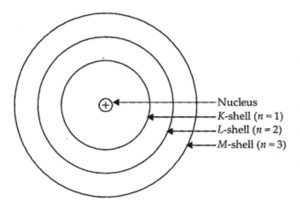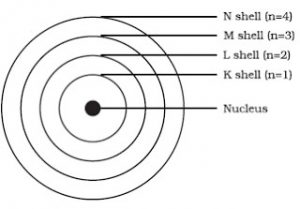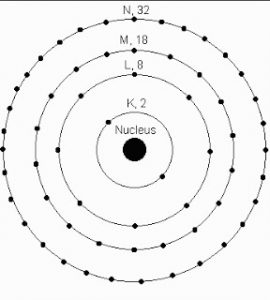Class 9 Science Chapter 4 Structure of the Atom NCERT Solutions
Page 47
1. What are canal rays?
Answer:
Canal rays are positively charged radiations. These rays consist of positively charged particles known as protons. They were discovered by Gold stein in 1886.
2. If an atom contains one electron and one proton, will it carry any charge or not?
Answer:
Since an electron is a negatively charged particle and the proton, a positively charged one, the net charge becomes neutral as both the particle neutralises each other.
Page 49 A
1.On the basis of Thomson’s model of an atom, explain how the atom is neutral as a whole.
Answer
An atom consist of a sphere of positive charge with negatively charged electrons embedded in it. The positive and negative charges in an atom are equal in magnitude, due to which an atom is electrically neutral. It has no overall positive and negative charge.
2. On the basis of Rutherford’s model of an atom, which subatomic particle is present in the
nucleus of an atom?
Answer:
On the basis of Rutherford’s model of an atom, protons (positively-charged particles) are present in the nucleus of an atom.
3. Draw a sketch of Bohr’s model of an atom with three shells.
Answer:
4. What do you think would be the observation if the α-particle scattering experiment is carried out using a foil of a metal other than gold?
Answer:
If the α-scattering experiment is carried out using a foil of a metal rather than gold, the observation would remain the same. In the α-scattering experiment, a gold foil was taken because gold is malleable and a thin foil of gold can be easily made. It is difficult to make such foils from other metals.
Page 49 B
1. Name the three sub-atomic particles of an atom.
Answer:
The three sub atomic particles of atom are electrons, protons and neutrons.
2. Helium atom has an atomic mass of 4 u and two protons in its nucleus. How many neutrons does it have?
Answer:
Atomic mass of helium =4u
Number of protons =2
Atomic mass = Number of protons+ Number of neutrons
4= 2+ Number of neutrons
Number of neutrons=2
Page 50
1 Write the distribution of electrons in carbon and sodium atoms?
Answer:
Carbon atom
Atomic number of Carbon = 6
First orbit or K-shell = 2 electrons
Second orbit or L-shell= 4 electrons
Distribution of electron= 2,4
Sodium atom
Atomic number of Carbon = 11
First orbit or K-shell = 2 electrons
Second orbit or L-shell= 8 electrons
Third orbit or M-shell =1 electron
Distribution of electron= 2,8,1
2 If K and L shells of an atom are full, then what would be the total number of electrons in the atom?
Answer:
The maximum number of electrons that can occupy K and L-shells of an atom are 2 and 8
respectively. Therefore, if K and L-shells of an atom are full, then the total number of electrons in
the atom would be (2 + 8) = 10 electrons.
Page 52 A
1. How will you find the valency of chlorine, sulphur and magnesium?
Answer:
The electrons present in outermost shell of an atom are called as valence electrons. The combining capacity of an atom of an element to form chemical bond is called its valency.
The valency of an element is
1)Equal to the number of valence electrons
2)Equal to the number of electrons required to complete eight electrons in valence shell.
Valency of a metal=No. of Valence electrons
Valency Of a non-metal=8-No. of valence electrons
Valency of Chlorine(Z=17)
Electronic Configuration=2,8,7
Valency=8-7=1
Valency of sulphur(Z=16)
Electronic Configuration=2,8,6
Valency=8-6=2
Valency of Magnesium(Z=12)
Electronic Configuration=2,8,2
Valency=2
Page 52 B
1. If number of electrons in an atom is 8 and number of protons is also 8, then
(i) what is the atomic number of the atom?
Answer:
The atomic number is equal to the number of protons. Therefore, the atomic number of
the atom is 8.
(ii) what is the charge on the atom?
Answer:
Since the number of both electrons and protons is equal, therefore, the charge on the
atom is 0.
2. With the help of Table 4.1, find out the mass number of oxygen and sulphur atom.
Answer:
Mass number of oxygen = Number of protons + Number of neutrons
= 8 + 8
= 16
Mass number of sulphur = Number of protons + Number of neutrons
= 16 +16
= 32
Page 53
1. For the symbol H,D and T tabulate three sub-atomic particles found in each of them.
2. Write the electronic configuration of any one pair of isotopes and isobars.
Answer:
Isotopes are the atoms of same element having same atomic number but different mass numbers.
Two isotopes of hydrogen are Protium 1H1 and deuterium 1H2
The electronic configuration of Protium 1H1 is 1
The electronic configuration of deuterium 1H2 is 1
Isobars are the atoms of different elements having different atomic number but same mass number.
29Ca40 and 18Ar40 are pair of isobars.
The electronic configuration of is 40Ca29 2, 8, 8, 2
The electronic configuration of 40Ar18 is 2, 8, 8.
Exercises Page 54
1. Compare the properties of electrons, protons and neutrons.
Answer:
| Electrons | Protons | Neutrons |
| Electron are present outside the nucleus of an atom. |
Proton are present in the nucleus of an atom. |
Neutron are present in the nucleus of an atom. |
| Electron are negatively charged |
Proton are positively charged. | Neutron are neutral. |
| The mass of an electron is considered to negligible. |
The mass of a proton is approximately 2000 times as the mass of an electron |
The mass of neutron is nearly equal to the mass of a proton. |
2. What are the limitations of J.J. Thomson’s model of the atom?
Answer:
J.J. Thomson in 1904, proposed that an atom was a sphere of positive electricity in which were embedded number of electrons. The stability of the atom was explained as a result of the balance between the repulsive forces between the electrons and their attraction towards the centre of the positive Sphere.This model could not explain the reason for exact stability of the atom.
3. What are the limitations of Rutherford’s model of the atom?
Answer:
He does not explain the stability of an atom. In the Rutherford’s model of an atom, the negatively charged electron revolves around the positively charged nucleus in circular path. If an object moves in a circular path, then its motion is said to be accelerated. This means that motion of an electron revolving around the nucleus is accelerated. If a charged particle undergoes accelerated motion, then it must radiate energy continuously. Thus the energy of revolving electron will decrease gradually and their speed will also go on decreasing. Ultimately the electrons should fall into the nucleus. This makes atom very unstable and hence the atom should collapse.
4. Describe Bohr’s model of the atom.
Answer:
1) An atom is made up of three particles: electrons, protons and neutrons. Electrons have negative charge, protons have positive charge whereas neutrons have no charge. Due the presence of equal number of negative electrons and positive protons, the atom on the whole is electrically neutral.
2)The protons and neutrons are located in a small nucleus at the centre of an atom. Due to the presence of protons, nucleus is positively charged.
3)The electrons revolve around the nucleus in fixed circular paths called energy levels or shells. The energy levels or shells are represented in two ways:
a)K,L,M,N…….
b)1,2,3,4,5……
4)The first energy level or k shell can hold maximum of 2 electrons.
The second energy level or L shell can hold maximum of 8 electrons.
The third energy level or M shell can hold maximum of 18 electrons.
The fourth energy level or N shell can hold maximum of 32 electrons.
5)Each energy level or shell is associated with fixed amount of energy. There is no change in energy as long as they keep revolving in same energy level.
6)The change in energy of an electron take place when it
a)Jumps from lower energy level to higher energy level(gain energy)
b)Jumps from higher energy level to lower energy level(Loses energy)
5. Compare all the proposed models of an atom given in this chapter.
Answer:
| Thomson model | Rutherford model | Bohr Model |
| An atom consists of a positively charged sphere with electrons embedded in it. |
|
There are only certain orbits know as discrete orbits inside the atom in which electrons revolve around the nucleus. Electrons do not radiate energy while revolving. |
6. Summaries the rules for writing of distribution of electrons in various shells for the first eighteen elements.
Answer:
The arrangement of electrons in various energy levels or shells of an atom is known as electronic configuration of the element.
The maximum number of electrons which can be accommodated in any energy level of an atom is given by 2n²(Bohr-Bury Rule).
For Ex: For 1st energy level n=1
Max number of electrons in 1st energy level=2n² =2
For 2nd energy level n=2
Max number of electrons in 2nd energy level= 8
For 3rd energy level n=3
Max number of electrons in 3rd energy level =18
Electrons in an atom do not occupy a new shell unless all the inner shells are completely filled with electrons.
7. Define valency by taking examples of silicon and oxygen?
Answer:
The outermost electron shell of an atom is called valence shell.
The electrons present in outermost shell of an atom are called as valence electrons.
The combining capacity of an atom of an element to form chemical bond is called its valency.
The valency of an element is
1)Equal to the number of valence electrons
2)Equal to the number of electrons required to complete eight electrons in valence shell.
Valency of a metal=No. of Valence electrons
Valency Of a non-metal=8-No. of valence electrons
Silicon
Atomic number of silicon= 14
Electronic configuration of si= 2,8,4
Valency of Silicon=4
Oxygen
Atomic number of oxygen= 8
Electronic configuration= 2,6
valency of oxygen= 8-6=2
8. Explain with examples (i) Atomic number, (ii) Mass number,
(iii) Isotopes and iv) Isobars. Give any two uses of isotopes.
Atomic number
The atomic number of an element is the total number of protons present in the atom of that element.
For Ex: Atomic number of sodium is 11.
Mass number
The mass number of an element is the sum of the number of protons and neutrons present in the
atom of that element.
For ex: The atom of boron has 5 protons and 6 neutrons. So, the mass number of boron is 5 + 6 = 11.
Isotopes
Isotopes are atoms of same element having same atomic number but different mass numbers.
For Ex:
Isotopes of Hydrogen
1H1 1H2 1H3
Uses of Isotopes
1) An isotope of Uranium is used as a fuel in nuclear reactor.
2) An isotope of cobalt is used in treatment of cancer.
Isobars
Isobars are the atoms of different elements having different atomic number but same mass number.
For Example, 6C12, 6C13, 6C14 are the three isotopes of carbon. They have the same atomic number but different mass numbers due to the difference in the number of neutrons.
9. Na+ has completely filled K and L shells. Explain.
Answer:
Atomic number of Na is 11.Its electronic configuration is 2,8,1.
The electronic configuration of Na+is 2,8.
The above configuration indicates completely filled K, L shells.
10. If bromine atom is available in the form of, say, two isotopes 79Br35 (49.7%) and 81Br35 (50.3%), calculate the average atomic mass of bromine atom.
Answer:
The average atomic mass of bromine
= [(79 x 49.7)+ (81 x 50.3)]/100
= [(3926.3 + 4074.3)]/100
= 8000.6/100
= 80 u
11. The average atomic mass of a sample of an element X is 16.2 u.
What are the percentages of isotopes 16X8 and 18X8 in the sample?
Answer: Since average atomic mass=[ 16 x X + 18 x (100 – X )]/100
16.2 = 16X + 1800 – 18X/100
1620 = – 2X + 1800
2X = 1800 – 1620
X = 180/2 = 90
When 90% is the X-16 sample so for X-18 sample % = 100-90=10%
12. If Z = 3, what would be the valency of the element? Also, name the element.
Answer:
Atomic number of element is 3.Its electronic configuration is 2,1.The valency of element is 1.Therefore the element is Lithium.
13. Composition of the nuclei of two atomic species X and Y are given as under:
| X | Y | |
| Protons | 6 | 6 |
| Neutrons | 6 | 8 |
Give the mass numbers of X and Y. What is the relation between the two species?
Answer :
Mass number of X = Number of protons + Number of neutrons
= 6 + 6
= 12
Mass number of Y = Number of protons + Number of neutrons
= 6 + 8
= 14
These two atomic species X and Y have the same atomic number, but different mass numbers.
Hence, they are isotopes.
14. For the following statements, write T for True and F for False.
(a) J.J. Thomson proposed that the nucleus of an atom contains only nucleons (F)
(b) A neutron is formed by an electron and a proton combining together. Therefore, it is neutral (F)
(c) The mass of an electron is about 12000 times that of proton (T)
(d) An isotope of iodine is used for making tincture iodine, which is used as a medicine ( T)
Put tick (√) against correct choice and cross (×) against wrong choice in questions 15, 16 and 17
15. Rutherford’s alpha-particle scattering experiment was responsible for the discovery of
(a) Atomic Nucleus (b) Electron
(c) Proton (d) Neutron
Answer:
(a) Atomic Nucleus (√)
(b) Electron(×)
(c) Proton(×)
(d) Neutron(×)
16. Isotopes of an element have
(a) the same physical properties
(b) different chemical properties
(c) different number of neutrons
(d) different atomic numbers.
Answer:
(a) the same physical properties (×)
(b) different chemical properties (×)
(c) different number of neutrons (√)
(d) different atomic numbers (×)
17. Number of valence electrons in Cl– ion are:
(a) 16 (b) 8 (c) 17 (d) 18
Answer: (b) 8
18. Which one of the following is a correct electronic configuration of sodium?
(a) 2,8 (b) 8,2,1 (c) 2,1,8 (d) 2,8,1.
Answer:(d) 2,8,1
19. Complete the following table.
Answer:






it has been proved very much helpful for me